Source: CCTV.com
09-08-2006 14:11
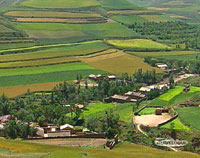 | |
For those who are into rugged frontier, off-the-beaten tracks, and original ethnic culture, Ningxia is the place to go because it's got just about everything you ask for. This scarcely populated region features a large variety of landscapes, such as the rolling Helan Mountain, winding Yellow River, the ancient Great Wall relics, refreshing lakes, and even golden Tengger dessert.
Although remotely stationed in the wild west of China, Ningxia Hui Autonomous Region is easily accessible by air or bus from major cities in the country. The road condition is surprisingly good, making it ideal for a driving tour.
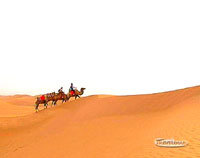 | |
About a third of the population in Ningxia belongs to Hui ethnic group, the Chinese Muslim tribe with a unique culture.
Historically, this secluded region was of military and commercial importance, and witnessed the come and go of many tough (strong) powers, among them the mysterious Western Xia Kingdom.
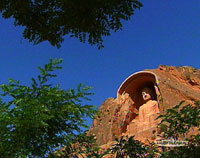 | |
In 11th century, Yuanhao, leader of the nomadic Dangxiang people, or known as Tongut people in the west, founded the Western Xia Kingdom in the Ningxia area. Less than 200 years later, Ghengis khan’s cavaliers conquered the Kingdom. Mongolian soldiers set everything on fire to revenge the loss of Genghis Khan who died on the fourth battle against Western Xia, turning numerous palaces, mausoleums into ruins.
The ambitious emperor resumed many of their own ancient traditions such as shaving bald and putting on double earrings. The Kingdom became a major power at the time.
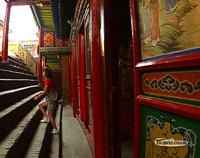 | |
Just like the mysterious disappearance of the Inca Empire and the Mayan culture, the once flourishing culture of the Western Xia Kingdom was suddenly wiped off history, leaving numerous mysteries to the present people.
Altogether, the Western Xia imperial mausoleum consists of the tombs of nine kings and covers an area of forty square kilometers along the foot of Helan mountain. It is comparable to the 13 Ming Dynasty mausoleums in the suburbs of Beijing, in terms of the scale and the condition of aboveground relics.
 | |
Although the written history of Western Xia was forever buried in the ashes of time, you can still feel a strong regal flair walking by those huge pagodas.
Helan mountain mouth makes a great hiking place with its breathtaking scenery and a rare bonus - thousands of rock carvings scattered in the mountain.
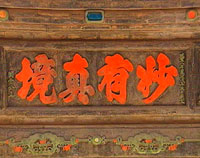 | |
Those Western Xia Characters, according to Xiaochen, mean To Buddhism can bring prosperity to the country. The ancient nomads left many paintings. It's believed that this huge rock was where some nomad tribes held their religious ceremony.
The barren rock mountain is also home to many rock sheep. You'll have to give them the kudos of surviving in such harsh environment.
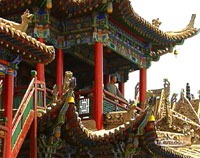 | |
Great wall
In the ancient time, the mountain mouth was also a military strategic point connecting Mongolia and Ningxia. Helan Mountain runs over 200 kilometers long from north to South at the border of Ningxia and Inner Mongolia.
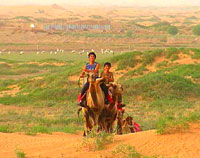 | |
Along the foot of Helan Mountain, extending for hundreds of kilometers are relics of Ming great wall.
Ningxia is known as the Museum of the ancient Great Wall. If you look at the map of Ningxia, you will find that the castellated symbol of Great wall outlines a large part of Ningxia border.
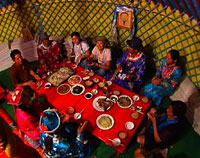 | |
No wonder so many moviemakers come to Ningxia, this everyday scene of sheep herding looks like a great movie setting to me.
Historically, Sanguankou of Helan Mountain was a critical military fort. It was through Sanguan kou that Ghengis khan's army came down upon Western Xia Kingdom from Mongolia.
The great wall in Sanguankou was built to keep out Mongols and other northern nomadic tribes many centuries ago. It extended for hundreds of kilometers along the Helan Mountain. Nowadays, only the section around Sanguankou is in good shape and has become a favorite for hikers, and local sheep.
After four centuries of silence, the architectural and archaeological features all around are ready to whisper speak, even shout their secrets to any hiker who will give some passing thought to what they see.
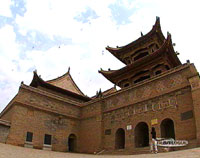 | |
Najiahu to the south of Yinchuan city is a village of Hui ethnic group. You can visit Grandpa Na Dongchen's house to get to know about the life and culture of Hui ethnic group.
All Hui people are Muslims. Before eating, they will read from Koran and pray. Grandpa Na is a prominent figure in the community. Out of the many things he takes pride in, a pilgrimage to mecca in 1997 is definitely a highlight.
 | |
Deeply influenced by Han culture, Ningxia Hui minority has many interesting traditions and customs, for instance, the custom of drinking 'eight treasure tea'.
Ningxia is the home to the best Wolfberry in the country. Other ingredients include Longan, sesame, chrysanthemum flowers and so on. The tea is said to be very nutritious. Another trademark food of Hui people is the fried pancake.
Originally built in 16th century, Najiahu Mosque is one of the earliest mosques in Ningxia. It perfectly combines typical Chinese architectural style with the Islamic decorative art. The mosque covers an area of 8,000 square meters with a worshipping hall that can fit over 1,000 people. Now it's open to the public outside of prayer time.
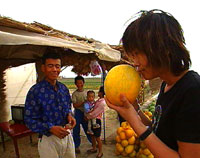 | |
The history of Hui people in Ningxia can be dated back to the late Tang Dynasty in 7th century when Some Persians and other Islamic believers came to China along the Silk Road and settled in Ningxia. Later, in 13th century, Mongolians, moved more Muslims from Arab and central Asia to the area after years of interracial marriage with local Han nationalities, Hui minority was gradually formed in Ningxia area.
Master Li dedicated years to the art of making and playing xun, an ancient instrument popular in the northwest of China.
Whereas the original Xun was only able to make five notes, his Xun can play modern tunes with every note.
Master Li also trained a small band that can perform Chinese classic music with Xun and other traditional Chinese instruments. Sipping a cup of green tea and listening to the graceful music, who would mind hanging around a little longer at this workshop?
 | |
Making Xun is not as easy as it looks. A very important step in making Xun is to drill the holes that decide the tune of a specific Xun. Xiao Zhang is the apprentice of Master Li. His dream is to open his own Xun workshop one day.
Sand lake is really a treat for Yinchuan residents. Surrounded by desert, dry land, it offers a precious playground for all kinds of fun water sports.
This huge marshland also harbors almost 100 different kinds of birds, among which are some rare species.
The natural landscape is impeccable at the lake. Helan Mountain, sand dune, water and reeds mesh together effortlessly.
No wonder Yinchuan is also known as the southern Watertown in the northwest.
Watching the sunset at sand lake, I just felt time goes too fast at Ningxia.
Editor:Chen Minji

